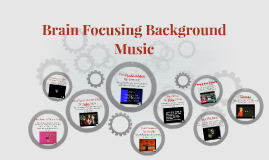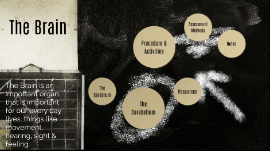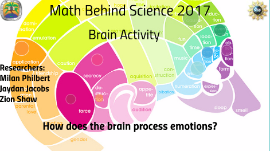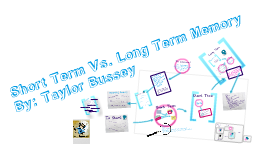Brain Presentation
Transcript: How does the brain process emotions? Researchers: Milan Philbert Jaydan Jacobs Zion Shaw Math Behind Science 2017 Brain Activity Abstract The purpose of this study is to show how the brain processes emotions. The brain is composed of various areas that perform tasks that result in the production of emotions. These areas of the brain make up a complex system of nerves and networks known as the Limbic System. The brain's emotional processes affect an individual physically, mentally and emotionally. Introduction "Emotion is defined as the state of mind a person is in at a particular moment, as well as the physiological response a person is experiencing at that time" (Ashcraft, Radvansky, 2014). In the brain, emotions are connected with a number of structures and areas consisting of the amygdala, the hippocampus, and the hypothalamus. "The amygdala is responsible for multiple emotional responses, like love, fear, anger and sexual desire, the hippocampus interacts with the amygdala when a person has memories with emotional ties, and lastly the hypothalamus acts as a regulator of emotion, controlling levels of sexual desire, pleasure, aggression and anger" (Stannard, 2011). Procedure Different steps were carried and gathered throughout this research: Articles supporting the topic were found online. Important details were then identified, annotated and made into topic outlines. Information that was not clear from the articles, were further researched on the internet. Results It was found that various parts of the brain perform various tasks which all lead to the production of emotions. According to author Shuo Wang, "most people are familiar with feeling that a face just looks too ambiguous to really decide what emotion the person is having". Researchers carried out a neuroimaging study using fMRI of recording single cells from the amygdala and additionally studied the emotion judgments of three rare subjects with impaired amygdalae. The impaired subjects showed an abnormally low threshold for deciding when a face was fearful. Conclusion This research was informative and influential and has boosted overall interest in the brain and its connections with other aspects of the body. This research will inspire other researchers to continue to learn more about the brain in the future. References Anne Trafton | MIT News Office. (2016, March 31). How the brain processes emotions. Retrieved July 25, 2017, from http://news.mit.edu/2016/brain-processes-emotions-mental-illness-depression-0331 McKay, S. (2016, October 24). How does the brain process emotions? Retrieved July 25, 2017, from http://yourbrainhealth.com.au/brain-process-emotions/ Facial Expressions: How Brains Process Emotion | Caltech. (n.d.). Retrieved July 25, 2017, from http://www.caltech.edu/news/facial-expressions-how-brains-process-emotion-54800 How the Brain Processes Emotions. (n.d.). Retrieved July 25, 2017, from http://www.neurologytimes.com/blog/how-brain-processes-emotions Acknowledgements By getting the opportunity to participate in the Math Behind Science Program, we were able to learn and experience college life. We would like to express our most sincere gratitude to Ms. Aimee Sanchez, Professor Wymer, Professor Teresa Turner, Mr. Andre Douglas, Mr. Avon Benjamin, Mr. Brandon Rhymer, Ms. Krislen Tison, Ms. Shequana Slader, sponsors, donors, the National Science Foundation and the wonderful UVI Staff for making this program such a wonderful experience.

















